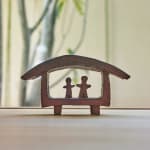Isamu Noguchi (1904–1988)
Home
Stoneware
Inscribed “no” on the bottom
W29.6 x H15.7 cm
Inscribed “no” on the bottom
W29.6 x H15.7 cm
Provenance
Collection of Dr. and Mrs. Dan HolbrookeExhibitions
Isamu Noguchi Exhibition. Kanagawa: Museum of Modern Art, Kamakura, 1952.Noguchi: Sculpture and Scroll Drawing. Chicago: The Arts Club of Chicago, 1955.
Isamu Noguchi Exhibition (1952) was the first show staged by the Museum of Modern Art, Kamakura, exhibiting artworks from a living artist in its capacity as a modern art museum. The show’s poster stated, “Isamu Noguchi’s true value is still not widely known in Japan.” The exhibition featured 119 works, including pottery sculptures and the first attempts at plates and pots. The objects were made in a studio in Kita-Kamakura that Noguchi borrowed from the masterful ceramicist Kitaoji Rosanjin (1883–1959) in May 1952. They were made using clay from Bizen, Seto, Shigaraki, Karatsu and red clay from Kasama. Noguchi spoke of how the clay of Japan had opened his eyes, as if he had found a new horizon, though he did question whether this was merely the reverberation of a childhood memory.
This work depicts two figures inside a house. In this sense, it is similar to another Noguchi work entitled Buson (Isamu Noguchi Foundation). However, while Buson features a solitary figure in Japanese clothes standing in a small hermit’s cell, Home presents a scene from contemporary life with its depiction of a house with an open window and door. We see a man and a woman standing under a bulging thatched roof. This pair may represent Noguchi and Yamaguchi Yoshiko, whom he married in December 1951. The woman wears a long skirt and the man a pair of trousers. With one side open, this room may be a recreation of the around 33-meter-square atelier built by Noguchi. While Buson used clay from Karatsu, for Home Noguchi selected red clay from Kasama, a more commonplace clay with a color similar to that of haniwa tomb figurines. Noguchi sensed a certain significance in the different colors and textures of fired clay. In Home, the bulky roof is shaped with different levels of thickness, as if representing the contradictory meaning of man and woman in a form connected to the everyday. “My symbolism derived from the prehistoric roofs of haniwa, like the protective abode of infancy, or even equating this with birth and death, the arch of peace with the dome of destruction.” As Noguchi’s own words suggest, this work perhaps provides a vivid representation of Noguchi as an artist forced to wrestle with the contradictory dualism of traditional Japanese techniques and a modernist sensibility.
Isamu Noguchi (sculptor; 1904–1988)
American sculptor, born in Los Angeles. Noguchi’s father was the Japanese poet Noguchi Yonejiro, his mother was the writer Leonie Gilmore. He initially studied medicine at Columbia University, but then decided to become a sculptor. Traveling extensively, including Europe, China, and Japan, Noguchi eventually expanded into designing public spaces, gardens, and furniture. His work is influential for introducing Japanese sensibilities into American art, but also for contributing to the spread of modernism in sculpture and ceramics in Japan.
This work depicts two figures inside a house. In this sense, it is similar to another Noguchi work entitled Buson (Isamu Noguchi Foundation). However, while Buson features a solitary figure in Japanese clothes standing in a small hermit’s cell, Home presents a scene from contemporary life with its depiction of a house with an open window and door. We see a man and a woman standing under a bulging thatched roof. This pair may represent Noguchi and Yamaguchi Yoshiko, whom he married in December 1951. The woman wears a long skirt and the man a pair of trousers. With one side open, this room may be a recreation of the around 33-meter-square atelier built by Noguchi. While Buson used clay from Karatsu, for Home Noguchi selected red clay from Kasama, a more commonplace clay with a color similar to that of haniwa tomb figurines. Noguchi sensed a certain significance in the different colors and textures of fired clay. In Home, the bulky roof is shaped with different levels of thickness, as if representing the contradictory meaning of man and woman in a form connected to the everyday. “My symbolism derived from the prehistoric roofs of haniwa, like the protective abode of infancy, or even equating this with birth and death, the arch of peace with the dome of destruction.” As Noguchi’s own words suggest, this work perhaps provides a vivid representation of Noguchi as an artist forced to wrestle with the contradictory dualism of traditional Japanese techniques and a modernist sensibility.
Isamu Noguchi (sculptor; 1904–1988)
American sculptor, born in Los Angeles. Noguchi’s father was the Japanese poet Noguchi Yonejiro, his mother was the writer Leonie Gilmore. He initially studied medicine at Columbia University, but then decided to become a sculptor. Traveling extensively, including Europe, China, and Japan, Noguchi eventually expanded into designing public spaces, gardens, and furniture. His work is influential for introducing Japanese sensibilities into American art, but also for contributing to the spread of modernism in sculpture and ceramics in Japan.



